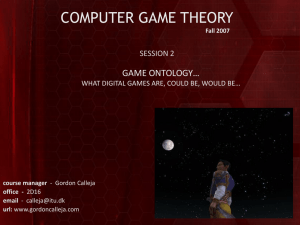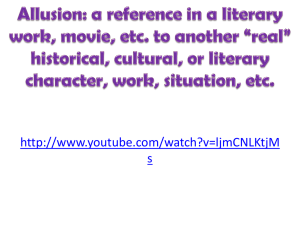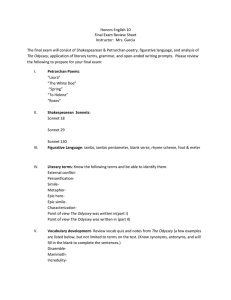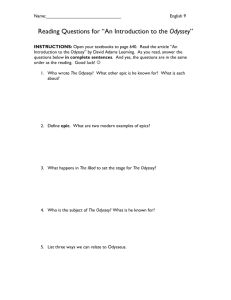igs_chapter_3 - An Introduction to Game Studies
advertisement
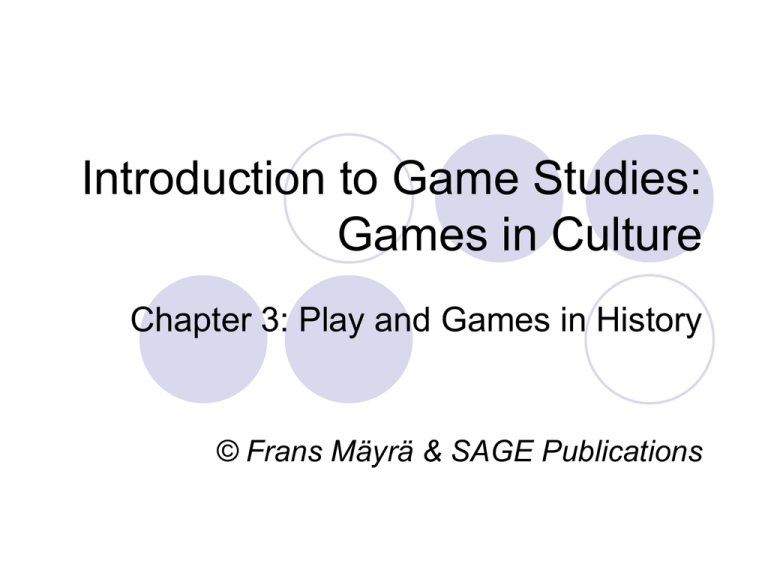
Introduction to Game Studies: Games in Culture Chapter 3: Play and Games in History © Frans Mäyrä & SAGE Publications Challenges for Game History Needed both aesthetic and formal study of games, as well as social and cultural study of play and players. Challenges for studying games in history: lack of archives and museums - no public preservation, not easy to play old games with original devices lack of professional historians working with games challenges for public recognition of the cultural value and significance of games - seen as questionable ‘low culture’ or industrially-produced ‘mass culture’. Perspectives for Digital Game History Digital game history not yet academically established as a domain of study. Multiple perspectives available: art historical perspective software industry perspective technology history perspective social historical perspective history of mentalities perspective games historiography, or meta-history. Art Historical Perspective Aims to describe in formal and aesthetical terms the development of digital games. Gives grounds for what the artistic and aesthetic criteria are for games’ audiovisual and interaction design in different decades. Provides perspective on how the concept of a ‘good’ or original game has changed over the years. Software Industry Perspective Focusing on the industry’s historical events and developments in the market place. Some alternatives: a case study approach; e.g. David Sheff, Game Over (1999), a book about Nintendo positioning games industry within the larger historical context of the software industry; e.g. Martin CampbellKelly, From Airline Reservations to Sonic the Hedgehog (2003) industry critique; e.g. Kline, Dyer-Witheford and Du Peyter, Digital Play (2003) biographical studies of industry luminaries. Technology History Perspective Fans are already engaged in cataloguing the various gaming devices of the past. Academic history of gaming technology would attempt to understand the wider social and cultural dynamics behind the changing hardware. c.f. published work in journals such as Technology and Culture, from the Society for the History of Technology. Social Historical Perspective Studying technology in relation to the social history. e.g. how changes in the family or working life, the amount of leisure time and money available to people from different social backgrounds, are related to the rise of a phenomenon like digital games. In more detail: social history of science and technology, the social-technological developments in different countries, the alternative or subversive histories of technologies as socially-constructed reality. History of Mentalities Perspective ‘Mentality’: loosely means ‘collective consciousness’ of a time. Histories of mentalities try to make sense of how certain kind of ideas or practices become prevalent in some contexts. Often done as ‘micro-histories’: studies that focus on small scale. A small group of people who at some point played or designed computer games might be a focus of such a micro-history. Games Historiography Games historiography is creating metahistory. Making sense of how we write about the history of games: what kind of activity it actually is, and what are the narratives, interpretations or other ‘discursive rules’ that govern this kind of writing. Defining Games How to define the ‘digital game’ as an object of study? What was the first digital game? Early digital games were closely related to earlier, non-digital games. Bolter & Grusin (1999): digital media ‘remediates’ earlier forms of media. The boundary between the digital game and earlier forms is not clear or absolute. Definition Game Formalist studies aim to capture the key formal characteristics of digital games. A formalist is not as interested in the ‘content’ or value of the game for some individual, as to the functions of the artistic form. Aristotle claimed that scientific knowledge should be based on a set of first principles that are necessarily true and directly knowable. Constructing and debating different definitions for digital games can easily look like a ‘language game’, an activity governed by rules of its own. Some Definitions: Caillois According to Roger Caillois, game playing is: an activity which is essentially: free (voluntary), separate [in time and space], uncertain, unproductive, governed by rules, make-believe. (Caillois, 1961: 10-11) Playing with toys can be part of game playing according to this definition. Range of play behaviours become large; ‘game’ as a category becomes loose. Some Definitions: Costikyan According to game designer and researcher Greg Costikyan: [game is:] an interactive structure of endogenous meaning that requires players to struggle toward a goal. (Costikyan, 2002: 16) The ‘endogenous’ part of this definition points back to the ‘magic circle’ of Huizinga. According to Costikyan, game’s structure creates its own meanings - the meaning grows out of the structure. Some Definitions: Jesper Juul According to the synthetic definition by Jesper Juul, in ‘classic game model’: a game is 1) a rule-based formal system; 2) with variable and quantifiable outcomes; 3) where different outcomes are assigned different values; 4) where the player exerts effort in order to influence the outcome; 5) the player feels emotionally attached to the outcome; 6) and the consequences of the activity are optional and negotiable. (Juul, 2005: 6-7) Informed compromise between generality and specificity - identifies several ‘borderline cases’. Borderline Games According to Juul there are several borderline cases that share some, but not all, of the criteria with the core of ‘classic game model’: gambling games of pure chance open-ended simulations pen-and-paper role playing. Discuss: how do each of these break games’ definitional criteria? Multiple Layers in Games Juul: “video games are real in that they consist of real rules with which players actually interact”; yet the digital game worlds are fictional - thus games are ‘half-real’. Salen & Zimmerman: “A game is a system in which players engage in an artificial conflict, defined by rules, that result in quantifiable outcome.” This ‘core’ game becomes realised during meaningful play at the multiple levels or schemas of rules, play and culture. RULES PLAY CULTURE Primary Schemas. Image credits: Katie Salen, Eric Zimmerman & The MIT Press. Prehistory of Games Games and play appear to be cultural universals - they are found everywhere. Anthropologist Edward Tylor (1879) suggested that dice games have their origin in divination. Sacred and profane use of games have existed side-by-side. Warning tales about games’ power, and laws regulating gambling and gameplay have been recorded from multiple societies. Games’ Holding Power Games are capable of capturing attention and energy, and holding them for extended periods of time. Societies have found it necessary to control this power of games in multiple ways. The holding power of games is one of the major research problems in Game Studies: why do we play games? Earliest Digital Games Impulse to ‘hack’, or play around with computers’ possibilities. Even in 1945, Alan Turing used chess playing as an example of what computer could do. The first functional chess program was written in 1950. UNIVAC, the first commercial computer, had construction costs close to one million dollars in 1951 - its use was extremely expensive and controlled. Tic-Tac-Toe (A. S. Douglas,1952) Early demonstration of computer game with graphical user interface: ‘OXO’, a version of tic-tac-toe for the British EDSAC computer. Tic-Tac-Toe, created by A. S. Douglas, 1952. Image credit: Martin Campbell-Kelly, Department of Computer Science, University of Warwick. See: http://www.dcs.warwick.ac.uk/~edsac/ Other Early Demonstrations In January 1947, a patent application for a ‘cathode-ray amusement device’ was recorded. The patent was granted to an electronic missile firing game, designed by Thomas T. Goldsmith Jr. and Estle Ray Mann. In 1958, Willy Higginbotham, working for Brookhaven National Laboratory, implemented a two-player tennis game using analogue computer and an oscilloscope for display. See ‘Tennis for Two’ video: http://real.bnl.gov/ramgen/bnl/pong.rm Early Commercial Video Games Commercial disputes surround the question of who ‘invented’ video games. Electronic games appear to have been implemented in various forms by multiple groups and individuals. Engineer Ralph Baer developed a commercial television game system in 19661969. The system became known as Magnavox Odyssey - it came packed with twelve games. Games of Magnavox Odyssey Source: http://www.pong-story.com/odyssey.htm Magnavox Odyssey Game Overlays. Image credit: David Winter, PONG-Story. From Spacewar! (1962) to Atari Stephen ‘Slug’ Russell, with fellow students, implemented an early ‘space shooter’ game for DEC Digital PDP-1 computer. Nolan Bushnell, with Ted Dabney, developed coin-operated arcade game Computer Space, released by Nutting Associates in 1971. Bushnell and Dabney founded Atari, Inc. in 1972, and released their tennis game, PONG, developed by engineer Al Alcorn. Sanders/Magnavox sued Atari, which settled out of court and paid licence fees to produce electronic ping-pong games – the video game industry had been born. Study of Play in Culture Romantics considered play as something that demonstrated free human behaviour and that essentially belonged to human nature. The surplus energy theory: holds that play has risen to consume the extra resources. Practise theories: learning is the root of play; play increases behavioural flexibility, Ambiguity of Play (Sutton-Smith) Almost anything can take place within play. Diverse forms of play: mind play, solitary play, playful behaviours, informal social play, vicarious audience play, performance play, celebrations and festivals, contests, games and sports, risky and deep play. Rhetorics of play: Play as Fate, Play as Power, Play as Identity, Play as Frivolity, Play as Progress, Play as the Imaginary, Play as the Self. (Sutton-Smith, 1997) Play as Performance According to sociologist Erving Goffman (1959), performance is “all of the activity of a given participant on a given occasion which serves to influence in any way any of the other participants”. Richard Schechner (2002) has provided a continuum of performance-related phenomena: play – games – sports – pop entertainments – performing arts – daily life – ritual. Games take place as play, and this can mean very different things depending on how the game is performed. Fantasy Play and Liminality Play has an important role in children’s development, as well as in adult life. Violent fantasy play is also considered important. According to child expert Vivian Gussin Paley (2002), play is based on pretending; escaping to the world of ‘what if?’ In various societies, rites of passage organise the transitions between cultural roles. The space of passage (limen, threshold) means momentary freedom from the rules of common behaviour and reality - as expressions of liminality. Russian philosopher Mikhail Bakhtin called this ambiguous area carnivalesque. Assignment: Remediation of a Non-Digital Game Pick a game that exists both as a digital and non-digital version. do a comparison and write about the different versions’ similarities and differences, strength and weaknesses.

